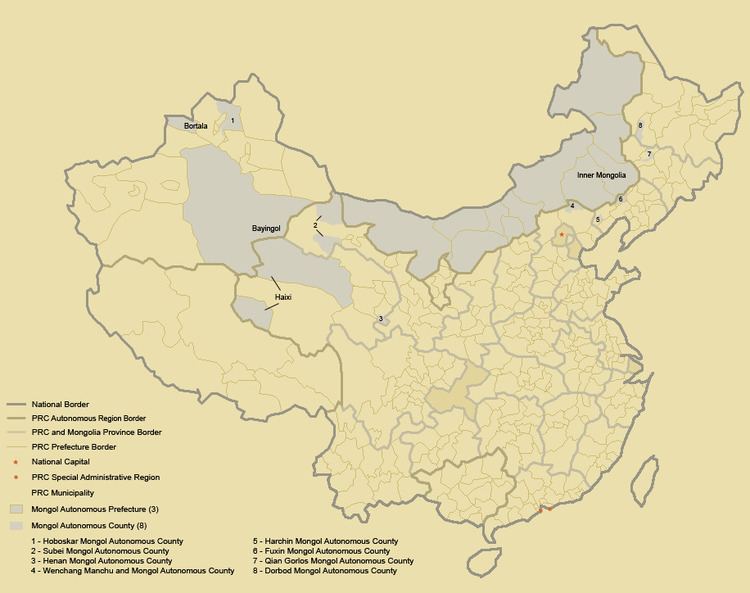Chinese Mongols (Chinese: 蒙古族; pinyin: Měnggǔzú) are citizens of the People's Republic of China who are ethnic Mongols. They form one of the 55 ethnic minorities officially recognized by the People's Republic of China. There are approximately 5.8 million people classified as ethnic Mongols living in China. Most of them live in Inner Mongolia, Northeast China, Xinjiang, etc. The Mongol population in China is over twice that of the sovereign state of Mongolia.
The Mongols in China are divided between autonomous regions and provinces as follows:
68.72%: Inner Mongolia Autonomous Region2.96%: Jilin Province2.92%: Hebei Province2.58%: Xinjiang Uyghur Autonomous Region2.43%: Heilongjiang Province1.48%: Qinghai Province1.41%: Henan Province5.98%: Rest of mainland ChinaBesides the Inner Mongolia autonomous region, there are other Mongol autonomous administrative subdivisions in China.
On prefecture level:
Haixi Mongol and Tibetan Autonomous Prefecture (Qinghai)Bayingolin Mongol Autonomous PrefectureBortala Mongol Autonomous PrefectureOn county level:
Weichang Manchu and Mongol Autonomous County (Hebei)Harqin Left Mongol Autonomous County (Liaoning)Fuxin Mongol Autonomous County (Liaoning)Qian Gorlos Mongol Autonomous County (Jilin)Dorbod Mongol Autonomous County (Heilongjiang)Subei Mongol Autonomous County (Gansu)Henan Mongol Autonomous County (Qinghai)Hoboksar Mongol Autonomous County (Xinjiang)China classifies diffent Mongolian groups like Buryats and Oirats into the same single category as Mongol along with Inner Mongols. A non-Mongolic ethnic group, the Tuvans are also classified as Mongols by China. The official language used for all of these Mongols in China is a literary standard based on the Chahar dialect of Mongol.
Not all groups of people related to the medieval Mongols are officially classified as Mongols under the current system. Other official ethnic groups in China which speak Mongolic languages include:
the Dongxiang of Gansu Provincethe Monguor of Qinghai and Gansu Provincesthe Daur of Inner Mongoliathe Bonan of Gansu Provincesome of the Yugurs of Gansu Province (other Yugurs speak a Turkic language)Sengge Rinchen, Qing dynasty nobleman and generalUlanhu, politician, former Chairman of Inner Mongolia, former Vice President of the People's RepublicBayanqolu, Communist Party Secretary of Jilin province, former Party Secretary of NingboUyunqimg, former Vice-Chair of the Standing Committee of the National People's CongressFu Ying, Deputy Foreign Minister, former ambassador to the United Kingdom, Australia, and the PhilippinesLi Siguang, geologist, founder of China's geomechanicsYang Shixian, chemist, chancellor of Nankai UniversitySiqin Gaowa, actressMengke Bateer, CBA and NBA basketball playerBao Xishun, one of the tallest people in the worldTengger, a pop/rock musicianBuren Bayaer, singer, composer and a disc jockeyUudam, child singerZhang Xiaoping,Chinggeltei (1924–2013), linguist, one of the world's few experts on the Khitan languageJalsan, linguist and Buddhist leaderBatdorj-in Baasanjab, actorXiao Qian academicBai Xue lawyer and legal academicBai Yansong, TV anchorHan Lei, pop singerWang Lijun, disgraced police chief and political figureBai Wenqi, lieutenant general of the PLA Air Force
